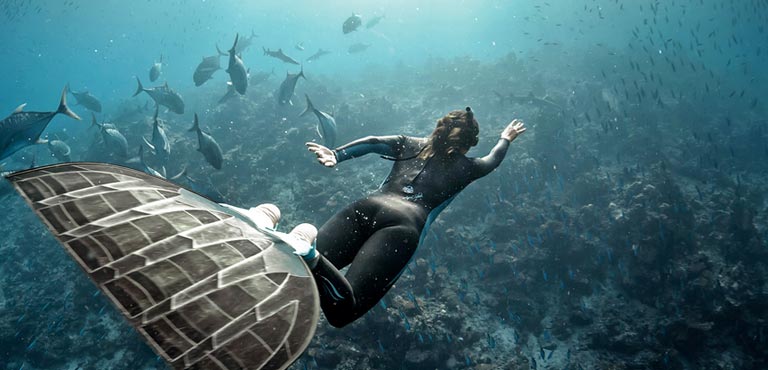Freediving brings peace, adventure
At the 60-foot depth, the ocean allows gravity to take control, creating a vortex that pulls divers to the fringe of Davy Jones’ Locker.
That free ride downward is caused by negative buoyancy and it’s one of Michelle Marsh’s favorite things about freediving. She calls it the sink phase.
“It’s exhilarating and when you pass 100 feet, you start flying,” Marsh said. “I can’t explain it — it’s a very free feeling that people usually don’t experience underwater.”
The peacefulness of the deep ocean also drives Marsh underwater as often as possible.
“It’s serene, and there’s a lot of physiological changes that happen to your body that you don’t really ever experience unless you’re freediving,” she said.
Marsh is one of Kauai’s deepest freedivers, currently reaching depths of 164 feet. She can hold her breath for five minutes, two seconds. Marsh was part TEAM USA World Freediving competition in September 2016.
As far as depth, Marsh is tied for the deepest freedive on Kauai — at least among those who have documented their dives.
During the TEAM USA competition, Marsh broke all of her records and the women’s team came in seventh place overall. Marsh hopes the team will place higher in the future.
“There are other countries where it’s a major national sport, so those countries tend to do better because they (freedivers) can make it their life,” Marsh said. The American team freedivers are “all pretty much part-time.”
As the United States becomes more interested in the sport, Marsh expects more support will follow for TEAM USA’s freedivers.
The Professional Association of Diving Instructors (PADI) began certifying freediving instructors in 2016, and Marsh sees that as a good sign for the sport’s popularity in the U.S.
“Once PADI puts its eye on something, it blows up,” she said. “We became certified in SCUBA in 2009 and PADI said ‘You shouldn’t be freediving.’ Now they’re teaching it.”
When she’s not training to compete, Marsh works with her business partner and fiancé, Josh Meneley, teaching the sport through their business, Freedive Kauai.
Meneley started freediving in 2012, after he started spending time with Marsh.
“I surf, and that kind of pushed my surfing, so I was getting bigger surf and diving deeper,” Meneley said. “Mainly, I coach.”
Meneley can reach depths of 146 feet and can hold his breath for about four minutes, 46 seconds.
Marsh has been on Kauai for 16 years and started freediving recreationally when she was a teenager growing up in Los Angeles.
“I didn’t know what I was doing,” she said. “In 2012, on my birthday, I went to Seasport Divers in Kapaa to get some longfins and this guy in there had a little class advertised.”
She and Meneley took the class, which was headed by world-class freediver, Kurt Chambers, and they never looked back.
Chambers has been setting national records in the freediving world and can dive to depths surpassing 330 feet. He also competes internationally and placed second in the Caribbean Cup in 2016.
“Kurt, he’s the one pushing the board for the sport. In the U.S., he’s the deepest diver,” Meneley said.
Chambers has been on-island, teaching a freediving class at Anini Beach Park over the weekend through today. The eager attitude among Kauai’s residents, paired with the low-key atmosphere, makes the island a favorite for teaching.
“I always think of Kauai as being the island with the most ‘stoke,’ as I have had my biggest classes there, as well as my youngest students,” Chambers said.
Some of those students have been as young as 9.
Kauai has a lot of people who spearfish, which is a “strong force for developing freediving ability,” Chambers said, but there’s also a large group of non-spearfishing divers that join classes.
Some of those people are into big wave surfing and sunrise shell collecting.
Anyone can learn how to freedive, and technically any time spent under the water without a breathing apparatus is considered freediving. But there are some prerequisites that help when learning the sport.
Being comfortable with the ocean is perhaps the most important. Others are understanding entry and exit with the waves, negotiating current, and not being afraid when the bottom isn’t visible, Chambers said.
While the Big Island is a favorite for freedivers because of clear, deep water and a plethora of sealife, Kauai also has a healthy population of sealife.
“I would still rank it above some of the other ones for convenience of reaching moderate depth within reasonable swimming distance from shore,” Chambers said.
Kauai’s challenges include exposure to tradewinds and wild weather.
“You don’t need to have any crazy experience to be able to freedive, you just need to be able to overcome stressful things, things your body isn’t used to,” Meneley said.


